
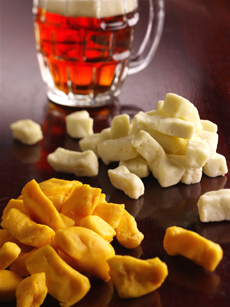
Cheddar cheese curds and plain cheese curds with a glass of ale: Who could ask for more?
|
KAREN HOCHMAN is Editorial Director of THE NIBBLE.
|
|
June 2007
|
 |
Wisconsin Cheese Curds
Plain Curds For Quick Snacking
Plus A Recipe For Fried Cheese Curds That’s A Special Treat
CAPSULE REPORT: If you love rope cheese, string cheese, mozzarella or cheese in general—but you’ve never had Cheddar cheese curds—you’ve got something to look forward to! Sold largely in Wisconsin, cheese curds have not been widely distributed because they need to be eaten fresh. A two-day-old curd is perceived like two-day-old cake—still edible, but you don’t want to buy it. Thankfully, innovations in packaging, including zip-seal type bags, may keep curds fresh in the refrigerator for months, and freezable for two years. Look for fresh cheese curds in a supermarket near you and get ready to celebrate.
You don’t have to be a cheese lover to love cheese curds. You just have to love fun foods. Even the lactose intolerant have been known to pop a Lactaid pill in order to enjoy a plate of curds—plain, flavored or deep fried. When you chew fresh curds, they “squeak” as they rub against your teeth. It’s a sign that they were made fresh that day—although tomorrow’s less squeaky curds are just as delicious.
Wisconsin is America’s largest cheese producer and by far, the largest producer of cheese curds. For a long time, only Wisconsinites and visitors knew the glory of cheese curds; but recent advances in packaging are making squeaky-fresh curds available nationwide. In Wisconsin, cheese curds are sold at virtually every supermarket and farmers’ market—and of course, at creameries where cheese is made. A fresh bag of curds is as much of a temptation to most people as a basket of fresh muffins: Resistance is futile. Deep-fried cheese curds with ranch dressing are enjoyed at casual restaurants instead of onion rings, fries or chips; bowls of fresh curds are served as bar snacks instead of peanuts or snack mixes. Whether plain, flavored or battered and deep fried, curds are a hit.
What Are Cheese Curds
Cheese curds are usually the fresh curds of young Cheddar cheese.* They would have become Cheddar, pressed into a mold and aged. Instead, the curds are removed from the vat and packaged for immediate sale in their natural form—random-shaped nuggets the size of unshelled peanuts. Curds are meant to be eaten the day they are made. While many people describe cheese the way they describe fresh-baked muffins—after 12 hours, the charm is gone, after 24 hours, the freshness is gone and in a few days, they start to dry out—vacuum packaging is helping to preserve curds for those of us who don’t live close to creameries or farmers’ markets.
* The consistency and curd shape of semi-soft and semi-hard cheeses lend themselves to cheese curds. Curds are also available in Monterey Jack and Brick cheeses, although Cheddar comprises the majority of what’s on the market, based on the popularity of the cheese.
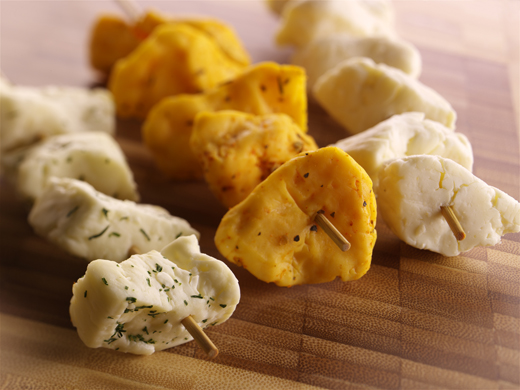 |
| Skewers of dill, jalapeño and plain curds: a fun alternative to a cheese plate. |
The origins of the first cheese curds as a separate food product are not known, but a reference to cheese curds was cited in a 1911 New York Times article, referred to a 12th-century Celtic song in which cheese curds were mentioned. Many curd lovers would join in that song.
Why Curds Squeak
Locals and tourists alike will drive to creameries and cheesemakers to purchase fresh curds—the fresher the better, most people feel, because they squeak more. Fresh curds have a looser curd structure, moist and slightly rubbery. These qualities produce the squeak when the cheese is eaten. Warm cheese curds generally have more squeak. As curds age—even for one day—the curd structure begins to tighten, decreasing the squeak. After several days: squeakless. The squeak can be restored by microwaving the curds for two to three seconds.
While many people cherish that squeak, we’d rather focus on the taste of a good cheese curd. which tends to have some mozzarella-like texture with more cheese flavor (remember—had this curd “grown up,” it would have been a Cheddar. We don’t want to listen to our food: It detracts from the gustatory enjoyment. We’d rather have the older, squeakless curd. Are we a curdmudgeon? Perhaps.
We’ve had curds that have retained their great flavor for weeks, even after the vacuum package was opened. Did we microwave them? Sure: melt them on toast for a great melted cheese sandwich. |
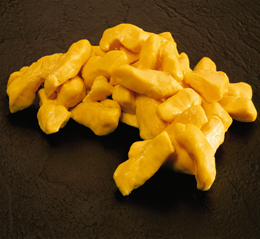
Young, fresh and squeaking. |
How Cheese Curds Are Made
Cheese curds begin life like all cheese: milk arrives in tanks at the cheese factory. It is weighed and tested for quality and purity, and then is pasteurized or heat-treated.
- It then goes into an enormous vat, where starter cultures (favorable bacteria) and/or enzymes are added to help curdle the milk and to determine the flavor and texture of the cheese. Different cultures are used to make different cheeses—Cheddar cultures are very different from blue cheese cultures, for example.
- Rennet, a milk-clotting enzyme is added to coagulate the milk and to form a gel-like mass, which is cut into small pieces to begin the separation of curds (milk solids) from whey (liquid). Curds and whey are cooked and stirred until the desired temperature and firmness of curd is achieved. The whey is either drained from the curds or the curds are dipped or pumped out of the vat.
- The curds are then salted, and any flavoring is added to create flavored curds. The curds are then ready to be packaged and sold to eager consumers. By the way, 10 pounds of milk will make about one pound of cheese—the other nine pounds are drained off in whey (which is repurposed into other products, from muscle-building whey powder to animal feed).
The shelf life is short; curds loose their “squeak” in as little as one day, and dry out in about a week. At that time, you can repurpose them into delicious melted cheese sandwiches, hot cheese dip, nachos, etc.
Making cheese curds at home is fairly complicated and requires ingredients, such as starter cultures and rennet, not readily available to consumers. However, it is possible—many chefs and some consumers make Fresh Mozzarella cheese or yogurt "cheese" in their own kitchens. We are not aware of any consumers making fresh Cheddar cheese curds or other varieties in their homes.
Flavored Cheese Curds
Just as vanilla is the number one ice cream flavor, plain Cheddar cheese curds—either white or colored yellow with annatto vegetable dye—are by far the most popular. However, cheesemakers offer a spice shelf of other flavors like Cajun, Chipotle, Dill, Garlic, Jalapeño, Onion, Paprika, Pesto, Pizza and Taco.
Fried Cheese Curds Recipe
|
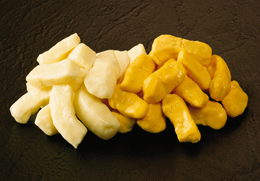
The most popular flavor: Plain Cheddar, in white or yellow. |
Want to know how to make cheese curds? While the process of making the actual curds is too difficult for a home kitchen, you can make scrumptious fried curds at home—our guests have become addicted to fried jalapeño cheese curds with a cold beer, although we fry up the plain ones for the less spicy-minded. Here’s a recipe for authentic Fried Wisconsin Cheddar Cheese curds. You can make them with the freshest curds, but deep-frying is also a good way to use up curds that are beginning to dry out.
Fried curds can be served with a ranch dressing dip, Wisconsin-style or with a marinara sauce—but they are absolutely heavenly by themselves (by which we mean, with a beer). This recipe serves 4.
Ingredients
- 2 cups Panko bread crumbs
- 2 teaspoons cornstarch
- 1 teaspoon ground cayenne pepper
- 1 tablespoon chopped fresh thyme
- 1 cup all-purpose flour
- 4 eggs, well beaten
- 1 pound Wisconsin cheese curds, 1" to 1-½" wide
- Oil for deep frying (high smoke point oils include avocado [520°F], safflower [510°F], soybean, corn, peanut and sunflower [450°F])
Directions
- Combine bread crumbs, cornstarch, cayenne pepper and chopped thyme in food processor. Process until bread crumbs are finely ground. Place in a pie plate.
- Place beaten eggs in another pie plate and flour in a third pie plate. Dredge the cheese curds in the flour, then the egg and lastly the bread crumb mixture.
- Place battered curds on a baking sheet. Set in the freezer for 20 minutes.
- Heat 3 inches of oil to 365°F to 375°F. Fry the cheese curds in batches until they are crisp and warmed all the way through. Season with salt and pepper. Serve immediately.
If you don’t want to do all the work, you can buy the cheese curd kit below
Buy Cheese Curds Online
Have delicious cheese curds delivered to you from these producers:
|
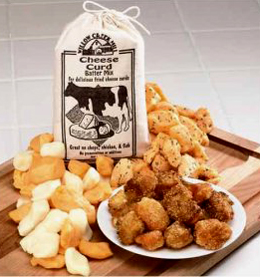
Get this cheese curd kit: yellow and white plain
curds plus garlic dill curds, and the batter to deep-
fry them. |
Many thanks to the Wisconsin Milk Marketing Board for their assistance in developing this article—and to the dairy farmers and cheesemakers of Wisconsin for making fun and tasty cheese curds as well as their many fine, award-winning cheeses. Read more about the great artisan cheeses of Wisconsin.
Lifestyle Direct, Inc. All rights reserved. Images are the copyright of their respective owners.

|






